A Critical Review of Existing Methods to Evaluate the Performance of Nature-Based Solutions (NBS) on Commercial Roofs (CR) to Mitigate Urban Flooding
Abstract
1. Introduction
- (i)
- Conduct, in laboratory, experimental tests to investigate parameters influencing the hydrological performance of NBS-CR and evaluate performance;
- (ii)
- Review field monitoring studies to investigate parameters influencing the hydrological performance of NBS-CR and evaluate performance;
- (iii)
- Identify research gaps and research limitations;
- (iv)
- Provide future recommendations.
1.1. Structure of the Literature Review
- Studies addressing the influencing parameters: (i) Climatic characteristics, (ii) Performance indicators;
- Background of NBS-CR;
- Review of experimental studies on parameters influencing retention performance;
- Review of field investigations on parameters influencing retention performance;
- Gap in the knowledge;
- Conclusions;
- References.
1.2. Background on NBS-CR
2. Review of Experimental Studies on Parameters Influencing Retention Performance
2.1. Influence of Rain Characteristics
2.2. The Influence of Substrate Characteristics
3. Review of Field Investigation Studies on Parameters Influencing Retention Performance
3.1. Influence of Roof System Configuration and Regional Climatic Conditions
3.2. The Influence of GR System Characteristic
3.3. The Influence of Rainfall Characteristics in Different Climatic Regions
4. Gap in Knowledge
4.1. Limitations of Experimental Work
- Many experiments may have a limited duration, providing insights into short-term hydrological behavior but not capturing the long-term dynamics and effects of green roofs over an extended period;
- The scale of experimental plots was primarily small, which does not directly reflect real-world applications, affecting the accuracy of extrapolating results to larger areas or different configurations. Thus, it is necessary to establish a correlation between the length effect and runoff coefficient to relate experimental tests to real-life scenarios;
- Existing experiments did not fully capture diverse rainfall patterns, including extreme rainfall events causing urban flash flooding, which are crucial for understanding the resilience of green roofs under different weather conditions;
- The experimental setting did not fully replicate interactions between green roofs and surrounding structures, impeding a comprehensive understanding of their hydrological impact in complex urban environments;
- The absence of standardized methodologies for assessing and reporting hydrological performance in green roof studies can make comparing results across different experiments challenging;
- Green roofs evolve over time, and their hydrological performance may change with plant growth, substrate settlement, and aging. Short-term experiments may not capture the dynamic nature of these systems.
4.2. Limitation of Field Monitoring Studies
4.3. Lack of a Test Protocol
- Local authorities typically set codes that include requirements or recommendations for managing stormwater on green roofs. Regulations may cover aspects such as water retention performance, usually determined by local government bodies or relevant authorities. These standards are compliance standards and not performance standards;
- There are no test protocols to regulate the design of green roof systems in the market. System regulations are significant in developing uniform design and testing requirements considering climate change while meeting structural requirements to mitigate urban flooding. Moreover, regulations will improve system quality, increase consumer availability, and accelerate mitigation efforts;
4.4. Lack of Knowledge in the Long-Term Performance
5. Conclusions and Future Recommendations
Author Contributions
Funding
Data Availability Statement
Acknowledgments
Conflicts of Interest
References
- IPCC. Climate Change 2022—Mitigation of Climate Change; Full Report, no. 1.; Working Group III contribution to the Sixth Assessment Report of the Intergovernmental Panel on Climate Change Mitigation of Climate Change; IPCC: Geneva, Switzerland, 2022; ISBN 9789291691609. [Google Scholar]
- City of Toronto, Combined Sewer Overflows. Available online: https://www.toronto.ca/services-payments/water-environment/managing-rain-melted-snow/what-is-stormwater-where-does-it-go/combined-sewer-overflows/ (accessed on 1 January 2024).
- Statistics Canada. Municipal Wastewater Systems in Canada, 2013 to 2017. The daily, No.11, pp. 1–5. 2019. Available online: https://www150.statcan.gc.ca/n1/daily-quotidien/190625/dq190625c-eng.pdf (accessed on 1 January 2024).
- Office of the Auditor General of Ontario. Climate Change Adaptation: Reducing Urban Flood Risk; Office of the Auditor General of Ontario: Toronto, ON, Canada, 2022.
- Ferreira, C.S.S.; Potočki, K.; Kapović-Solomun, M.; Kalantari, Z. Nature-Based Solutions for Flood Mitigation and Resilience in Urban Areas. In Handbook of Environmental Chemistry; Springer: Cham, Switzerland, 2021; Volume 107, pp. 59–78. [Google Scholar] [CrossRef]
- Lebeuf, P.A. Cerner L’impact De La Végétalisation Du Bâtiment Comme Solution Durable Pour Les Organisations; Essai présenté au Centre universitaire de formation en environnement et développement durable en vue de l’obtention du grade de maître en environnement (M. Env.); Université de Sherbrooke: Sherbrooke, QC, Canada, 2018. [Google Scholar]
- FLL. Guidelines for the Planning, Construction and Maintenance of Green Roofs; Forschungsge-sellschaft Landschaftsentwicklung Landschaftsbau (FLL): Bonn, Germany, 2018; 150p. [Google Scholar]
- City of Toronto. Toronto Green Roof Construction Standard and the Supplementary Guidelines; City of Toronto: Toronto, ON, Canada, 2017. [Google Scholar]
- ASTM E2398; Standard Test Method for Water Capture and Media Retention of Geocomposite Drain Layers for Green Roof Systems. ASTM International: West Conshohocken, PA, USA, 2019; p. 3. [CrossRef]
- ASTM-2397; Standard Practice for Determination of Dead Loads and Live Loads Associated with Green Roof Systems. ASTM International: West Conshohocken, PA, USA, 2019; p. 6. [CrossRef]
- Canadian Commission on Building and Fire Codes. National Building Code of Canada 2020; National Research Council of Canada: Ottawa, ON, Canada, 2020. [Google Scholar]
- Canadian Commission on Building and Fire Codes. National Plumbing Code of Canada 2020; National Research Council of Canada: Ottawa, ON, Canada, 2020. [Google Scholar]
- Alim, M.A.; Jahan, S.; Rahman, A.; Rahman, M.A.; Liebman, M.; Garner, B.; Griffith, R.; Griffith, M.; Tao, Z. Experimental investigation of a multilayer detention roof for stormwater management. J. Clean. Prod. 2023, 395, 136413. [Google Scholar] [CrossRef]
- Yao, A.Y. Agricultural potential estimated from the ratio of actual to potential evapotranspiration. Agric. Meteorol. 1974, 13, 405–417. [Google Scholar] [CrossRef]
- Voyde, E.; Fassman, E.; Simcock, R. Hydrology of an extensive living roof under sub-tropical climate conditions in Auckland, New Zealand. J. Hydrol. 2010, 394, 384–395. [Google Scholar] [CrossRef]
- Sims, A.W.; Robinson, C.E.; Smart, C.C.; Voogt, J.A.; Hay, G.J.; Lundholm, J.T.; Powers, B.; O’carroll, D.M. Retention performance of green roofs in three different climate regions. J. Hydrol. 2016, 542, 115–124. [Google Scholar] [CrossRef]
- Shafique, M.; Lee, D.; Kim, R. A Field Study to Evaluate Runoff Quantity from Blue Roof and Green Blue Roof in an Urban Area. Int. J. Control. Autom. 2016, 9, 59–68. [Google Scholar] [CrossRef]
- Squier-Babcock, M.; Davidson, C.I. Hydrologic Performance of an Extensive Green Roof in Syracuse, NY. Water 2020, 12, 1535. [Google Scholar] [CrossRef]
- Hamouz, V.; Pons, V.; Sivertsen, E.; Raspati, G.S.; Bertrand-Krajewski, J.-L.; Muthanna, T.M. Detention-based green roofs for stormwater management under extreme precipitation due to climate change. Blue-Green Syst. 2020, 2, 250–266. [Google Scholar] [CrossRef]
- Almaaitah, T.; Joksimovic, D. Hydrologic and Thermal Performance of a Full-Scale Farmed Blue–Green Roof. Water 2022, 14, 1700. [Google Scholar] [CrossRef]
- Richter, M.; Dickhaut, W. Long-Term Performance of Blue-Green Roof Systems—Results of a Building-Scale Monitoring Study in Hamburg, Germany. Water 2023, 15, 2806. [Google Scholar] [CrossRef]
- Wong, G.K.; Jim, C. Quantitative hydrologic performance of extensive green roof under humid-tropical rainfall regime. Ecol. Eng. 2014, 70, 366–378. [Google Scholar] [CrossRef]
- Stovin, V.; Poë, S.; De-Ville, S.; Berretta, C. The influence of substrate and vegetation configuration on green roof hydrological performance. Ecol. Eng. 2015, 85, 159–172. [Google Scholar] [CrossRef]
- Zhang, S.; Lin, Z.; Zhang, S.; Ge, D. Stormwater retention and detention performance of green roofs with different substrates: Observational data and hydrological simulations. J. Environ. Manag. 2021, 291, 112682. [Google Scholar] [CrossRef]
- Park, S.-Y.; Oh, D.-K.; Lee, S.-Y.; Yeum, K.-J.; Yoon, Y.-H.; Ju, J.-H. Combined Effects of Substrate Depth and Vegetation of Green Roofs on Runoff and Phytoremediation under Heavy Rain. Water 2022, 14, 2792. [Google Scholar] [CrossRef]
- Villarreal, E.L.; Bengtsson, L. Response of a Sedum green-roof to individual rain events. Ecol. Eng. 2005, 25, 1–7. [Google Scholar] [CrossRef]
- Lee, J.; Moon, H.; Kim, T.; Kim, H.; Han, M. Quantitative analysis on the urban flood mitigation effect by the extensive green roof system. Environ. Pollut. 2013, 181, 257–261. [Google Scholar] [CrossRef]
- Lee, J.Y.; Lee, M.J.; Han, M. A pilot study to evaluate runoff quantity from green roofs. J. Environ. Manag. 2015, 152, 171–176. [Google Scholar] [CrossRef] [PubMed]
- Zhang, Z.; Szota, C.; Fletcher, T.D.; Williams, N.S.G.; Farrell, C. Green roof storage capacity can be more important than evapotranspiration for retention performance. J. Environ. Manag. 2019, 232, 404–412. [Google Scholar] [CrossRef] [PubMed]
- da Silva, M.; Najjar, M.K.; Hammad, A.W.A.; Haddad, A.; Vazquez, E. Assessing the Retention Capacity of an Experimental Green Roof Prototype. Water 2019, 12, 90. [Google Scholar] [CrossRef]
- Loiola, C.; Mary, W.; da Silva, L.P. Hydrological performance of modular-tray green roof systems for increasing the resilience of mega-cities to climate change. J. Hydrol. 2019, 573, 1057–1066. [Google Scholar] [CrossRef]
- Razzaghmanesh, M.; Beecham, S. The hydrological behaviour of extensive and intensive green roofs in a dry climate. Sci. Total Environ. 2014, 499, 284–296. [Google Scholar] [CrossRef] [PubMed]
- Giacomello, E.; Gaspari, J. Hydrologic Performance of an Extensive Green Roof under Intense Rain Events: Results from a Rain-Chamber Simulation. Sustainability 2021, 13, 3078. [Google Scholar] [CrossRef]
- Liu, W.; Feng, Q.; Chen, W.; Wei, W.; Deo, R.C. The influence of structural factors on stormwater runoff retention of extensive green roofs: New evidence from scale-based models and real experiments. J. Hydrol. 2019, 569, 230–238. [Google Scholar] [CrossRef]
- Kemp, S.; Hadley, P.; Blanuša, T. The influence of plant type on green roof rainfall retention. Urban Ecosyst. 2019, 22, 355–366. [Google Scholar] [CrossRef]
- Graceson, A.; Hare, M.; Monaghan, J.; Hall, N. The water retention capabilities of growing media for green roofs. Ecol. Eng. 2013, 61, 328–334. [Google Scholar] [CrossRef]
- Alfredo, K.; Montalto, F.; Goldstein, A. Observed and Modeled Performances of Prototype Green Roof Test Plots Subjected to Simulated Low- and High-Intensity Precipitations in a Laboratory Experiment. J. Hydrol. Eng. 2010, 15, 444–457. [Google Scholar] [CrossRef]
- Johannessen, B.G.; Muthanna, T.M.; Braskerud, B.C. Detention and Retention Behavior of Four Extensive Green Roofs in Three Nordic Climate Zones. Water 2018, 10, 671. [Google Scholar] [CrossRef]
- Todorov, D.; Driscoll, C.T.; Todorova, S. Long-term and seasonal hydrologic performance of an extensive green roof. Hydrol. Process. 2018, 32, 2471–2482. [Google Scholar] [CrossRef]
- Rowe, D.B.; Getter, K.L. Improving stormwater retention on green roofs. J. Living Archit. 2022, 9, 20–36. [Google Scholar]
- Pumo, D.; Francipane, A.; Alongi, F.; Noto, L.V. The potential of multilayer green roofs for stormwater management in urban area under semi-arid Mediterranean climate conditions. J. Environ. Manag. 2023, 326, 116643. [Google Scholar] [CrossRef]
- Förster, K.; Westerholt, D.; Kraft, P.; Lösken, G. Unprecedented Retention Capabilities of Extensive Green Roofs—New Design Approaches and an Open-Source Model. Front. Water 2021, 3, 1–14. [Google Scholar] [CrossRef]
- Jensen, R.G.; Burman, M.E.; Allen, R.D. Evapotranspiration and Irrigation Water Requirements: A Manual; ASCE: Reston, VA, USA, 1990. [Google Scholar]
- Campisano, A.; Modica, C.; Gullotta, A. Long-term experiments for the evaluation of the potential for storm water control of modular blue roofs in Mediterranean climate. Urban Water J. 2020, 18, 33–42. [Google Scholar] [CrossRef]
- Yin, H.; Kong, F.; Dronova, I. Hydrological performance of extensive green roofs in response to different rain events in a subtropical monsoon climate. Landsc. Ecol. Eng. 2019, 15, 297–313. [Google Scholar] [CrossRef]
- Bengtsson, L.; Grahn, L.; Olsson, J. Hydrological function of a thin extensive green roof in southern Sweden. Hydrol. Res. 2005, 36, 259–268. [Google Scholar] [CrossRef]
- Berretta, C.; Poë, S.; Stovin, V. Moisture content behaviour in extensive green roofs during dry periods: The influence of vegetation and substrate characteristics. J. Hydrol. 2014, 511, 374–386. [Google Scholar] [CrossRef]
- Schultz, I.; Sailor, D.J.; Starry, O. Effects of substrate depth and precipitation characteristics on stormwater retention by two green roofs in Portland OR. J. Hydrol. Reg. Stud. 2018, 18, 110–118. [Google Scholar] [CrossRef]
- Almaaitah, T.; Almaaitah, T.; Drake, J.; Drake, J.; Joksimovic, D.; Joksimovic, D. Impact of design variables on hydrologic and thermal performance of green, blue-green and blue roofs. Blue-Green Syst. 2022, 4, 135–155. [Google Scholar] [CrossRef]
- Bortolini, L.; Bettella, F.; Zanin, G. Hydrological Behaviour of Extensive Green Roofs with Native Plants in the Humid Subtropical Climate Context. Water 2021, 13, 44. [Google Scholar] [CrossRef]
- Berti, A.; Tardivo, G.; Chiaudani, A.; Rech, F.; Borin, M. Assessing reference evapotranspiration by the Hargreaves method in north-eastern Italy. Agric. Water Manag. 2014, 140, 20–25. [Google Scholar] [CrossRef]
- Pereira, L.S. Crop Evapotranspiration-Guidelines for Computing Crop Water Requirements-FAO Irrigation and Drainage Paper 56. 1998. Available online: https://www.researchgate.net/publication/235704197 (accessed on 1 January 2024).
- Villarreal, E.L. Runoff detention effect of a sedum green-roof. Hydrol. Res. 2007, 38, 99–105. [Google Scholar] [CrossRef]
- Getter, K.L.; Rowe, D.B.; Andresen, J.A. Quantifying the effect of slope on extensive green roof stormwater retention. Ecol. Eng. 2007, 31, 225–231. [Google Scholar] [CrossRef]
- Carson, T.B.; Marasco, D.E.; Culligan, P.J.; McGillis, W.R. Hydrological performance of extensive green roofs in New York City: Observations and multi-year modeling of three full-scale systems. Environ. Res. Lett. 2013, 8, 024036. [Google Scholar] [CrossRef]
- Montalto, F.; Behr, C.; Alfredo, K.; Wolf, M.; Arye, M.; Walsh, M. Rapid assessment of the cost-effectiveness of low impact development for CSO control. Landsc. Urban Plan. 2007, 82, 117–131. [Google Scholar] [CrossRef]
- Carter, T.L.; Rasmussen, T.C. HYDROLOGIC BEHAVIOR OF VEGETATED ROOFS. JAWRA J. Am. Water Resour. Assoc. 2006, 42, 1261–1274. [Google Scholar] [CrossRef]
- Silva, F.; Calheiros, C.S.C.; Valle, G.; Pinto, P.; Albuquerque, A.; Antão-Geraldes, A.M. Influence of Green Roofs on the Design of a Public Stormwater Drainage System: A Case Study. Sustainability 2023, 15, 5762. [Google Scholar] [CrossRef]
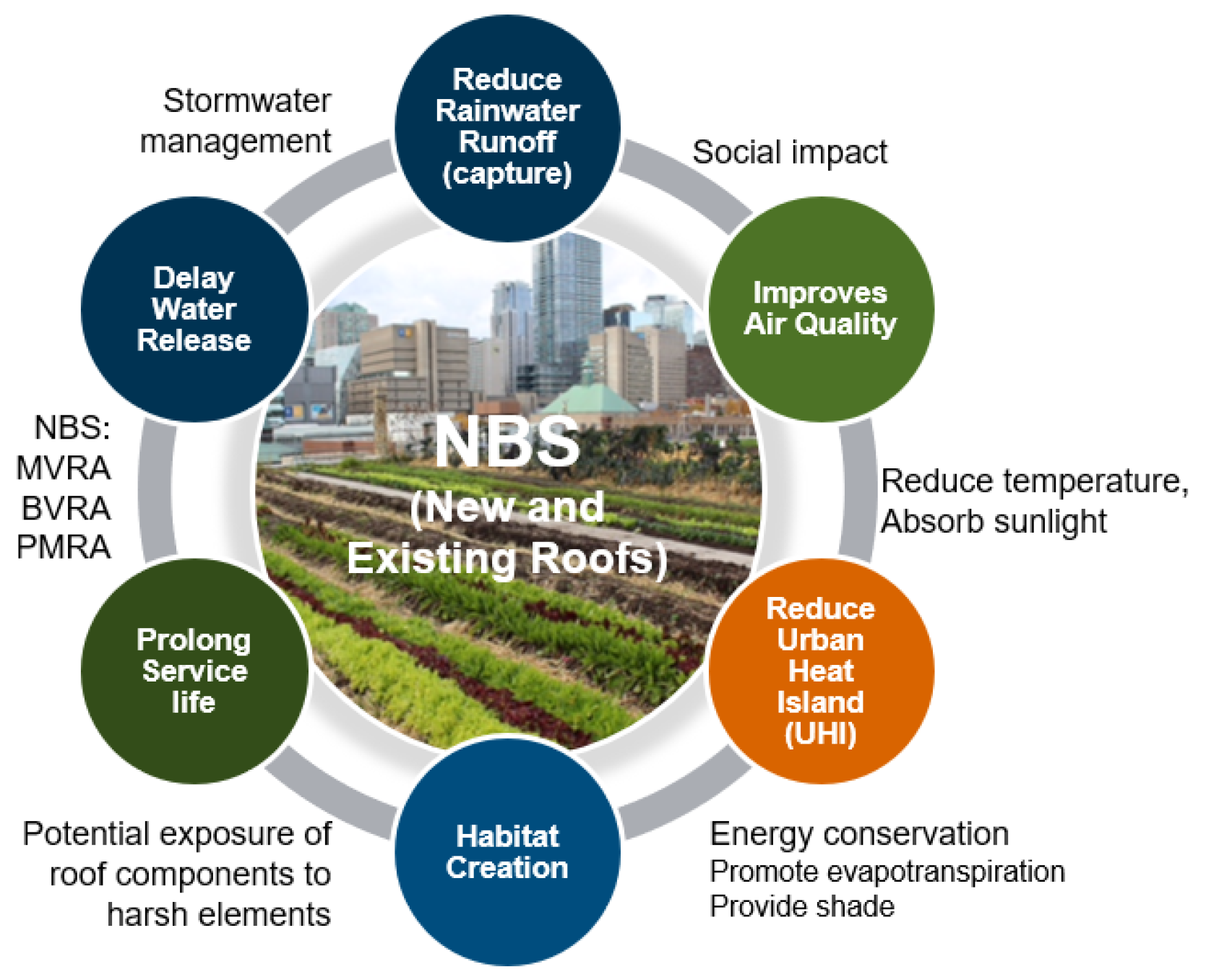
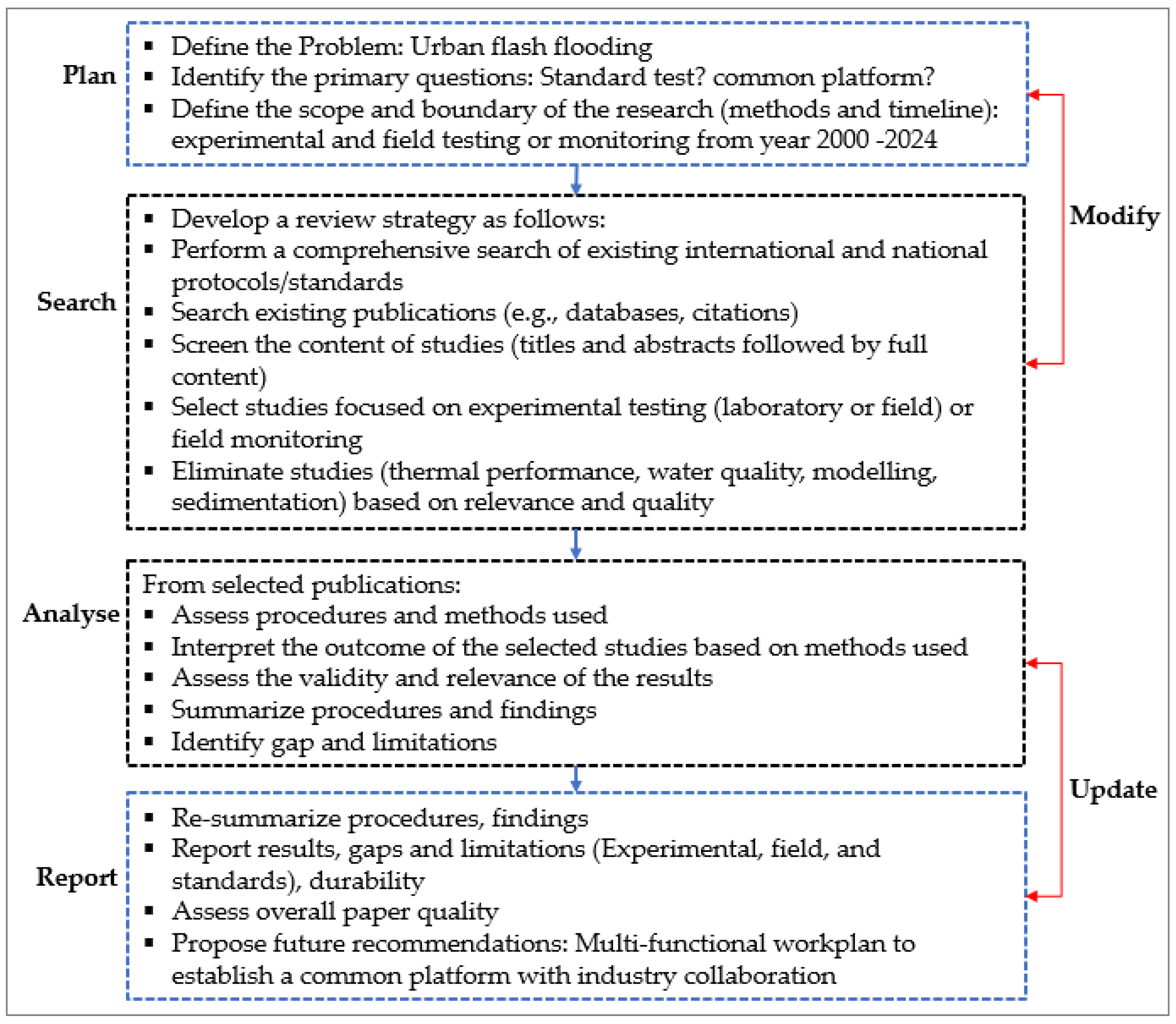
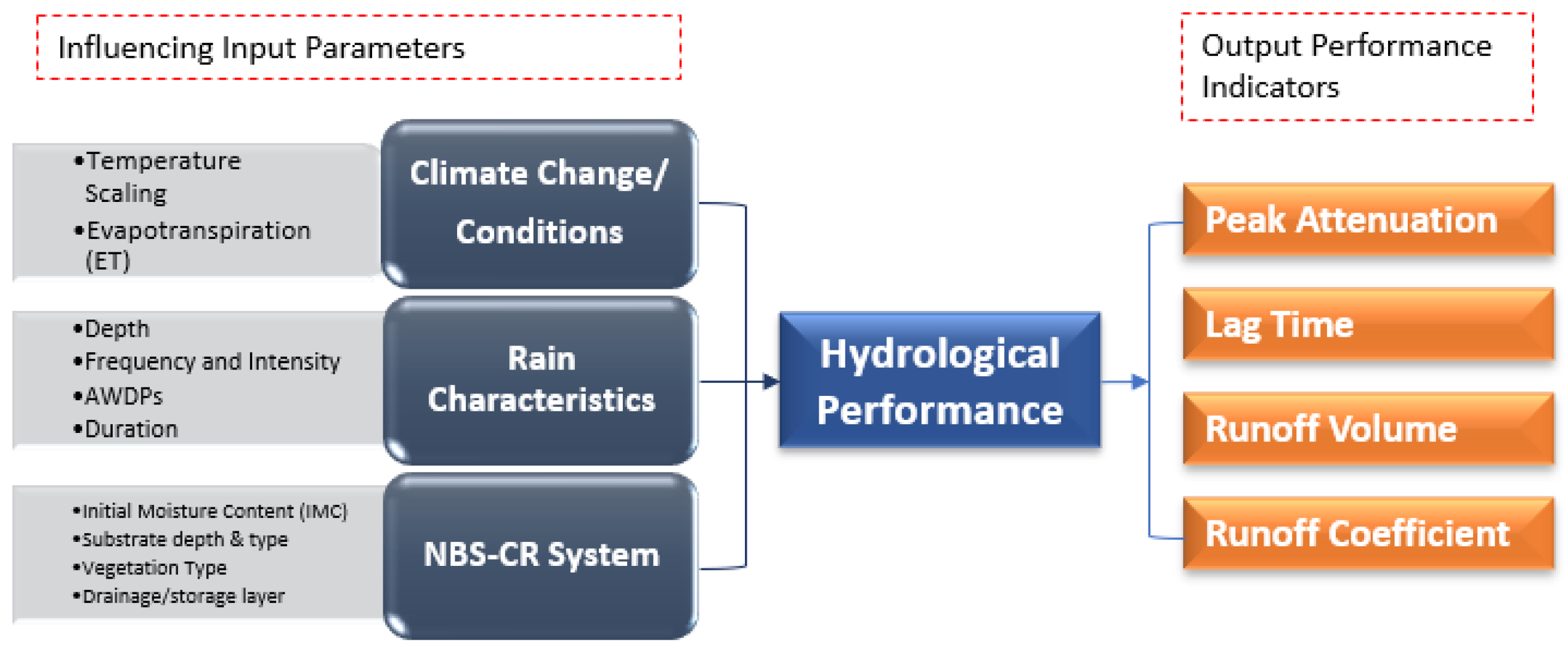
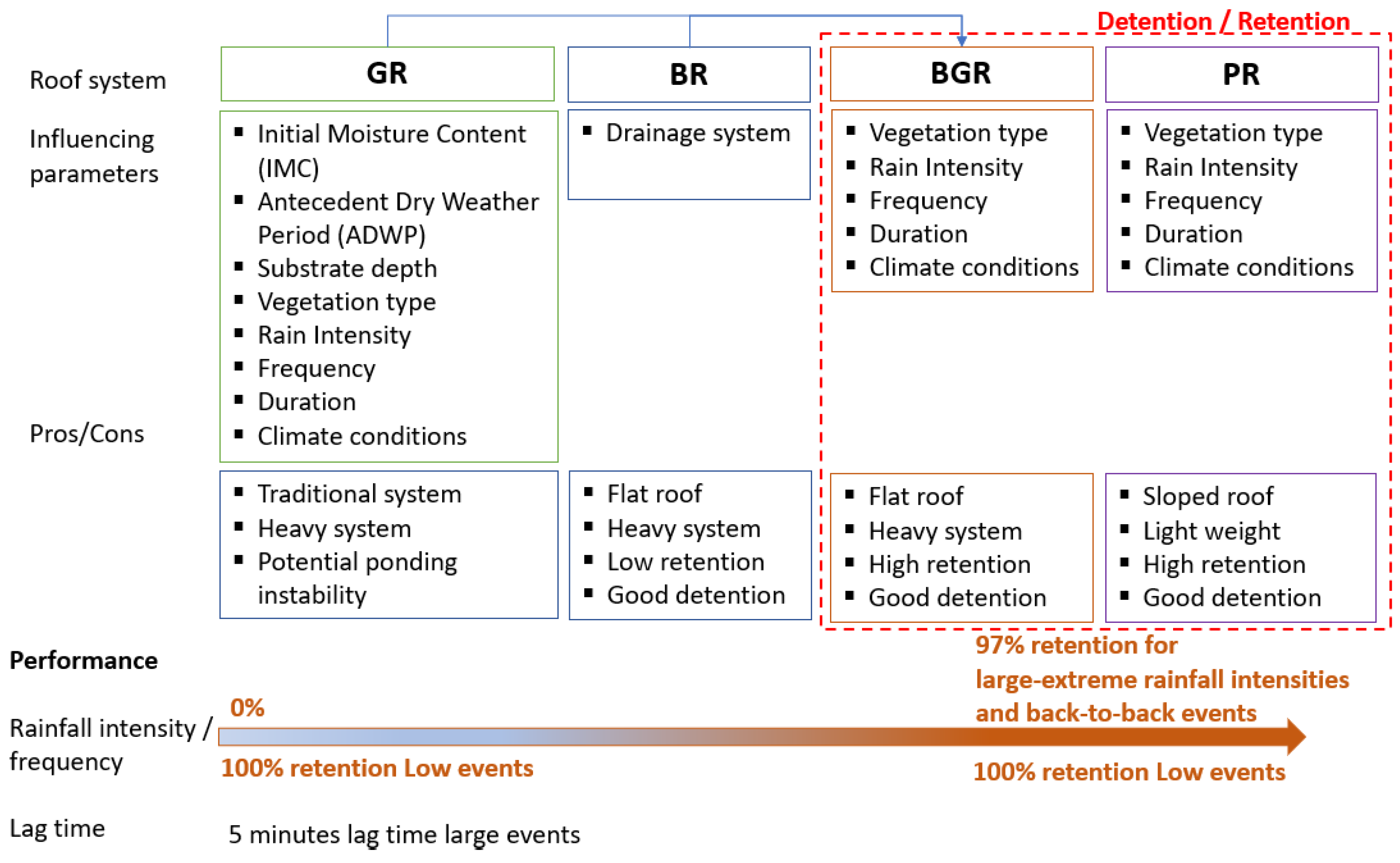
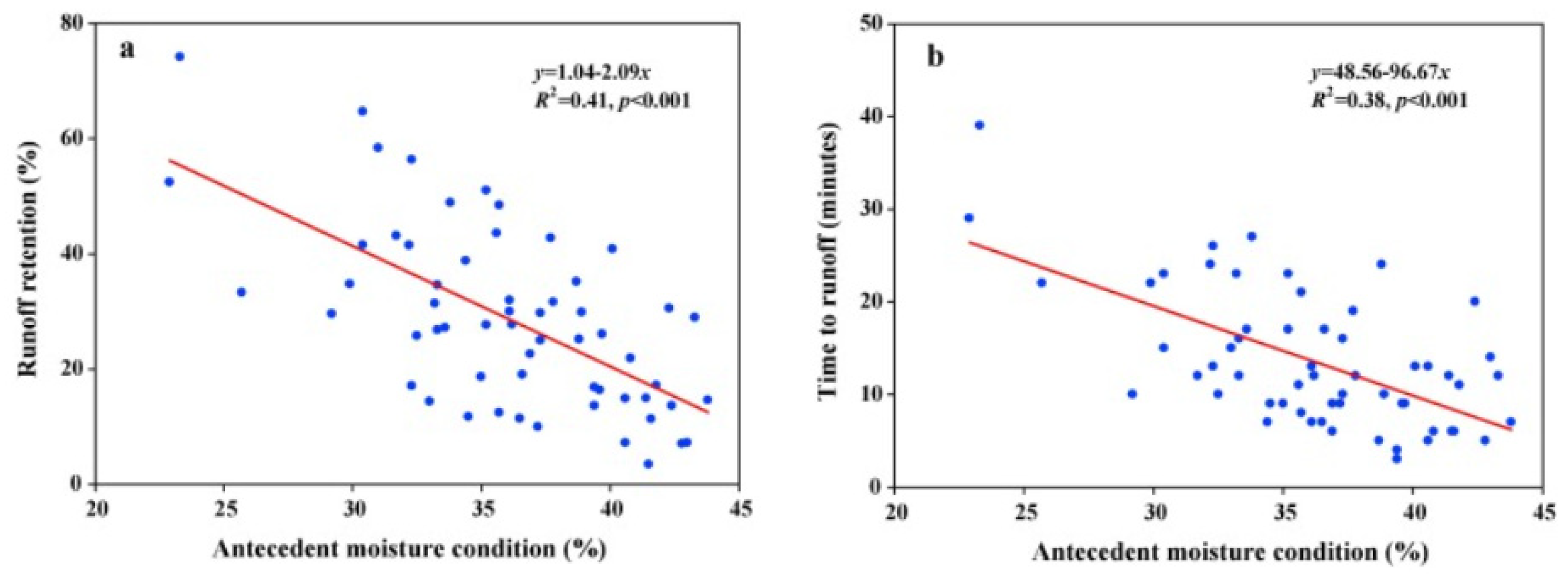
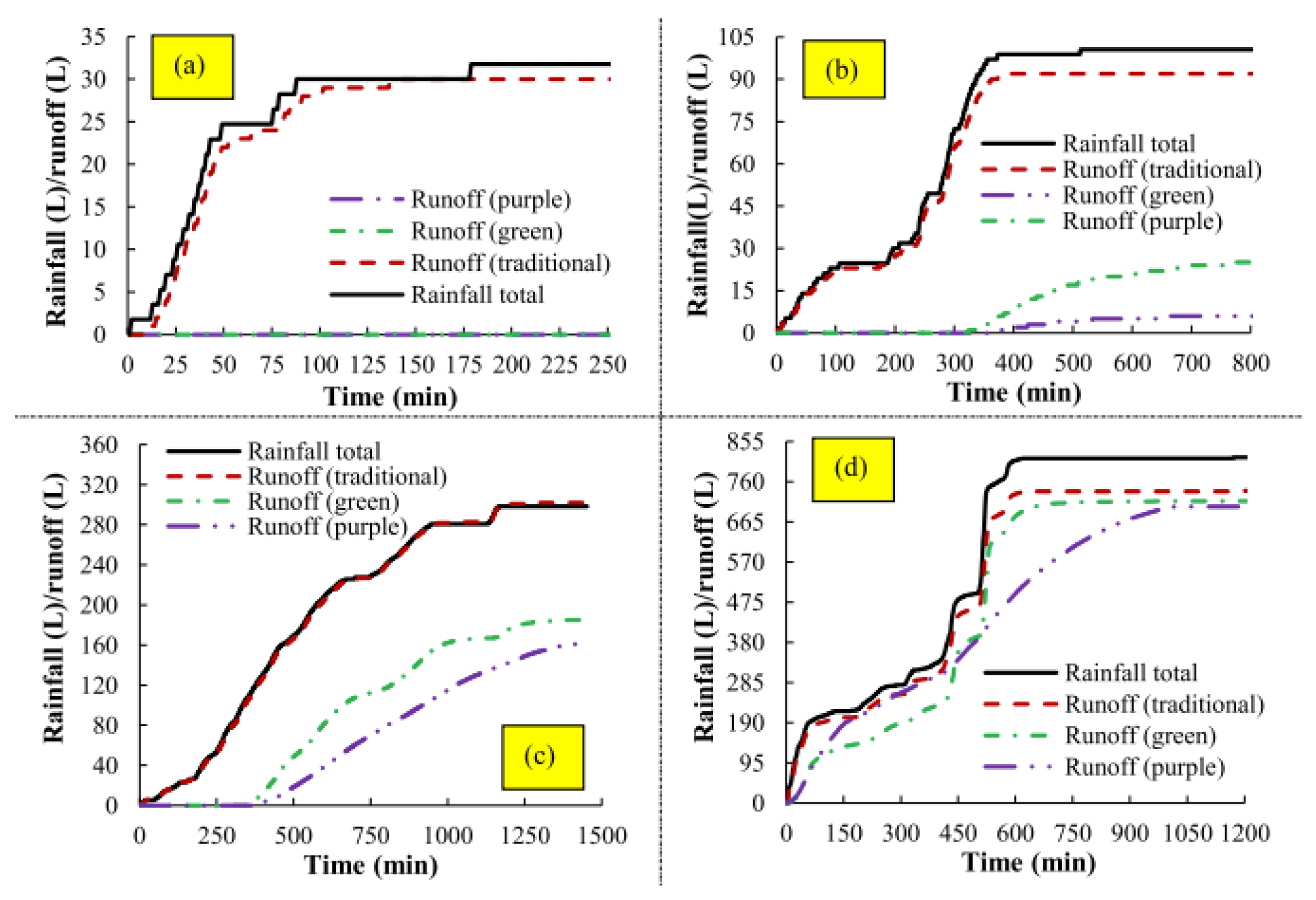

| Canadian City | Date | Cost (Canadian Dollars) (Insured) | Intensity (mm/Hour) | Duration (Hour) | Depth (mm) |
|---|---|---|---|---|---|
| Thunder Bay | May 2012 | 240 million | 16.7 | 6 | 100 |
| Hamilton | July 2012 | 104 million | 46.7 | 3 | 140 |
| Toronto | July 2013 | 1 billion | 51.0 | 2 | 102 |
| Burlington | August 2014 | 166 million | 25.0 | 8 | 200 |
| Windsor and Tecumseh | September 2016 | 178 million | 50.0 | 4 | 200 |
| Windsor and Tecumseh | August 2017 | 178 million | 5.9 | 48 | 285 |
| Toronto | August 2018 | 169 million | 36.0 | 2 | 72 |
| Ref. | Variable | Climate Conditions. Location | Rain Simulator (Small Scale) | Rain Intensity, Ia | Findings |
|---|---|---|---|---|---|
| [33] | Rain intensity | Mild continental climate (warm–humid summer, very cold winter). Quinto Vicentino, Italy | Extensive GR. 5000 × 1000 × 1000 mm with 300 nozzles | 1.8 mm/min (9 mm/5 min) 17 mm/5 min 18 or 24 h FLL | The mitigation capacity of the GR system depends on IMC, F.C., and ADWPs. GR’s ability to retain water diminishes following back-to-back events due to saturation. Lower retention following intense rain events. |
| [19] | IMC, Rain intensity | Norwegian cities | Extensive GR. Sedum, expanded clay layer, 130 mm | 0.8–2.5 mm/min between 30–90 min 5–74 min, 6 h | Hydrological performance is highly affected by the growing media’s IWC for short and long-duration rain events. The IWC increased from a field capacity of 15 mm to 55 mm, and the centroid delay decreased from 20 min to 5 and 10 min. Peak attenuation was 93%. |
| [30] | Rain intensity | The tropical Savanna monsoon climate. (Heavy rain from March to December). Rio De Janeiro, Brazil | Extensive GR. 5 modules sized 2000 × 890 mm placed outdoors. The bottom drainage is into two taps towards a gutter and a pliviometer. The gutter slope is 0.3%. | 1.8–2.5 mm/min (110–150 mm/h) 1.8 (115 mm/h) 6,7 days 2.4 mm/min (145 mm/h), 4 to 14 days | GR reduces lag time in intense rain events but does not affect peak runoff reduction. ADWPs lead to higher retention capacity. Retention capacity is higher at higher rainfall intensities, 68 and 82% for 116 and 146, respectively. |
| [34] | Rain intensity Substrate depth type. | Combination of cold desert, cold semiarid, temperate continental, and cool continental climate. Gansu, China | Extensive GR. 10-platforms sized 1000 × 1000 × 300 mm. Raised above ground by 500 mm. Drainage: middle of drainage layer connected by a pipe 25 mm.Substrate depth: 50, 100, 150 mm, Type: Radix, Sedum, Iris. Roof slope: 2, 7, 12% | Low: 21 mm, 60 min, 0.34 mm/min. High: 20 mm, 30min, 0.6 mm/min | Factors influencing hydrological performance substrate material, substrate depth, slope. Higher retention capacity is observed for substrates that have higher field capacity. Radix Ophiopogonis had lower runoff retention compared to the Sedum Spectabile vegetation. Higher retention lag time for low-intensity events. A slight decrease in retention capacity following slope increases from 2% to 12%. |
| [29] | Plant type Wet/dry | A temperate oceanic climate (warm summers, mild winters). Melbourne, Australia | Extensive GR.18 modules sized 1150 × 1150 mm. Different vegetations: (1) bare un-planted substrate (control); (2) Sedum pachyphyllum; (3)Lomandra longifolia; (4) Dianella admixta; (5) Stypandra glauca; (6) mixture of Lomandra longifolia, Dianella admixta and Stypandra glauca | 0.8 mm/min (49 mm/h), ADWP (0, 2, 4, 6, 9, 12 days) | Rainfall depth is the main driver for water retention. However, proper selection of vegetation species influences the retention capacity. High ET reduces retention. Species roots reduce the storage capacity of the substrate. Limitations: ET was not quantified on the day of the experiment. |
| [31] | Rain Intensity Plant type Wet/dry | The tropical Savanna monsoon climate. (Heavy rain from March to December), Rio De Janeiro, Brazil | Extensive GR. 6 modules sized 500 × 500mm on rooftop (6% slope). Runoff is controlled using a stopwatch. | Intense rainfall, 2.5 mm/min (155 mm/h) and 7 min. Wet and Dry soil conditions | GR is less efficient in retaining water during wet conditions. Bare soil was drier as it drained faster compared to vegetative soil. Succulent vegetation loses less water and retains less water. Emphasize proper selection of vegetation species for a particular climate where frequent rainfall occurs. |
| [35] | Vegetation type and ET | Maritime climate, Yorkshire, UK | Extensive GR Heuchera micrantha, Salvia officinalis, and Stachys byzantine | 0.5 mm/min (9 mm/20 min) | Stachys and Salvia exhibited the highest ET, then Heuchera, and Sedum had the lowest ET. Bare substrate showed the lowest ET. Vegetation species exhibiting high ET rates, such as Salvia and Stachys, could retain 72% water due to ET effects compared to 46% retention for sedum plants. |
| [28] | Substrate depth | Humid continental climate with dry winter. Seoul, Korea | Extensive GR.1000 × 1000 × 700 mm, Substrate depth 150 or 200 mm. | E1–E7 from (0.04 to 0.13 mm/min) | Increase ADWP, improve retention capacity, and decrease delayed time (td). High I has a negative relation with delayed time. GR is effective for low-I events. |
| [27] | Rain intensity | Humid continental climate dry winter. Seoul, Korea | Extensive GR. 500 × 500 × 200 mm. Drainage: four at the corners and one at the center base. | Spring–Fall: 2–20 mm/h. ADWPs: 1–5 days Summer: 2–40. ADWPs 0.5–3 NE. | As rainfall intensity increased above 20 mm/h, retaining capacity decreased. |
| [37] | Rain intensity. FC. | The tropical Savanna climate Monsoon climate, Brazil | Extensive GR.4 platforms 1220 × 61 mm. One control and 3vegetation. Sedum plants. | Uniform rainfall, Low I, short duration. High I. 1 h duration. 0.3–0.4 mm/min (18 to 25 mm/h). | Retention capacity is reduced following an intense rainfall event. |
| [26] | Rain intensity, slope | Mild Oceanic, Augustenborg, Sweden | Controlled field test. GR. Sedum moss, 300 mm substrate, Slopes 2, 5, 8, 14° | 0.4, 0.8, 1.3 mm/min | ET significantly reduces runoff. Runoff initiates once FC. is reached. The roof slope does not influence the runoff. |
| Ref. | Variable | Climate/Location | NBS-CR Details | Rainfall Intensity | Month | Findings |
|---|---|---|---|---|---|---|
| [13] | Rain intensities Roof system | Subtropical climate (hot-humid summer, cool to mild winter). Sydney, Australia | GR, PR, conventional, small-scale: raised platforms sized 1200 × 6000 × 150 mm | Categorized rainfall | 13 | Purple effectively mitigates performance, especially during heavy and extreme events or when the substrate reaches capacity during back-to-back events. Runoff reduction was 88 and 55% compared to conventional and GR. |
| [41] | Rain intensities IMC, roof system | Mediterranean climate (Hot-dry summer, mild-wet winter) Palermo, Sicily, Italy | BGRs, Full-scale rooftop 2% monitoring (69 m2). Vegetative layer and storage layer | 54 events over 4 mm rain depth | 14 | Emphasize the influence of rainfall characteristics, initial soil moisture in the green layer, and the initial water storage in the blue layer on the system’s ability to retain water. |
| [21] | Roof system, long term | Oceanic climate (wet-windy, mild winter). Hamburg, Germany | BGRs Full-scale rooftop monitoring | Rain depth >0.2 mm | 72 | Growth in the vegetation biodiversity due to water storage, which sustains water availability during dry periods |
| [58] | Pipe sizing the drainage system | Macedonia’s climate (warm, dry summers and autumns, cold winters, heavy snowfall) Macedo de Cavaleiros, Northeast, Portugal | Extensive GR, sloped impermeable smooth roof. Flat roof | Rainfall intensities for all three roofing scenarios were <2 mm/min | NA | Reduction in water runoff by 16% compared to conventional roof system. |
| [40] | Roof systems | Humid continental climate. East Lansing, MI, USA | Small-scale: 21 platforms (1220 × 1220 mm). LiveRoofStandard (S), S and RoofBlue RETAIN (SB), LiveRoof Lite (L), L and B (LB); Substrate and Rockwool (R), RoofStone Pavers (RS); Membrane (M); Gravel Ballast (G); and G and RoofSponge (GR). | Categorized rainfall | 8 | The retention performance for different GR systems is reduced as the rainfall depth increases. |
| [49] | Substrate type. System type | Continental climate (dry climate, hot summers, very cold winter) Toronto, ON, Canada | BGR, BR., GR. Small-scale. Six modules sized 2400 × 1200 mm on the rooftop sectioned into three systems with a middle drainage hole. Substrate depth 100 mm GR, 50 mm BGR | Maximum rainfall depth 47 mm. June–November. | 3 | Organic-based substrates can retain more water than FLL substrates, which may not be suitable for growing drought-tolerant plants. |
| [20] | Plant species. Roof systems | Continental climate. Toronto, ON, Canada | BGR, BR., GR Full scale. Intensive rooftop farm-3 plots (11 × 20 m). Continuous beds (19,000 mm long by 760 mm wide) separated by a 450 mm path. Soil depth 250 mm | From 7 mm to 103 mm rain depth | 5 | Rooftop performance: mean retention, peak attenuation, and peak delay ranges of 85–88%, 82–85%, and 7.7–8 h. Influencing performance were the high-quality organic substrate and the extended drainage layer. |
| [25] | Substrate depth | Hot, humid summers, cool-dry winters. (Monsoon climate in Korea | Extensive GR small scale. Twenty-one platforms (500 × 500 × 500 mm), nine vegetation and nine no vegetation, three control. Soil depth of 100, 200, and 400 mm | Extreme rainfall 63, 93, 284 mm/h | 3 | Higher substrate depth has a more significant impact in reducing runoff rate than the vegetation type. |
| [24] | Substrate depth, type | Monsoon-influenced climate. Beijing, China | Extensive GR, 6 GR modules sized 1000 × 1000 × 400 mm Substrate depth: 100, 150 mm. | Rain 0.2 to 132 mm, intensity: 0.04 to 2.76 mm/min. | 72 | No significant difference in performance between the two systems under light rain (<10 mm) and short ADWPs. |
| Ref. | Variable | Climate, Location | System Details | Rainfall Intensity | Duration (Month) | Findings |
|---|---|---|---|---|---|---|
| [50] | Plant species, Substrate type, Drainage storage | Subtropical climate, Northeastern Italy | Extensive GR, small-scale in the field 36 platforms (0.44 m2) raised 1000 mm above ground. Middle drainage hole. Volcanic substrate (120 mm), recycled substrate (120 mm) | Variable rainfall events | 24 | Runoff for VS is higher than RS. and not affected by PL. or ML. ML reduced runoff more than PL. Events > 25mm, retained rainfall volume varied (20–80%) depending on ADWPs. Retention capacity (85–95%) was higher for a medium rain event of (10–25mm). For <10mm, 100% retention. Species suffruticose (SF.) reduced runoff by 15.2% compared to Sedum (SE.) plants. |
| [44] | Roof system (BR) | Mediterranean Climate, Catania, South Italy | BR rooftop size: 4600 × 5720 mm. 1.6% roof slope. 64 tray modules. Spaced at 400 mm. 645 × 417 mm. 115 mm in depth. | 73 events.26 used. 169 mm/h | 24 | BR had 34% runoff reduction and 60% peak attenuation compared to a conventional roof. BR. was empty before successive rain events. |
| [19] | Rain Intensity, IMC | Local climatic conditions Bergen, Oslo, Trondheim, Norway. | Extensive GR, Rooftop 88 m2, 2%, 1000 mm AG. GR underlaid with 200mm expanded clay | Local climatic conditions | 12 | The performance of the roof is dependent on multiple variables, including the initial moisture content of the substrate. |
| [18] | Evapotranspiration (ET) | Humid continental climate. New York, NY, USA | Extensive GR, Live roof Setup 300 × 300 mm. Substrate depth 150 mm | >20 mm 11 events | 21 | Evapotranspiration plays a crucial role in restoring the retention capacity between rainfall events. |
| [45] | Extreme rainfall event (Monsoon) | Humid subtropical climate. Nanjing, China | Extensive GR, five-story rooftop area 1101 m2, divided into two independent sections: bare and GR Pre-grown vegetated (Sedum lineare) modules 300 × 500 × 110 mm. The substrate layer is 70 mm | 16 days 2–10 mm 13 days 10–25 mm, 20 days >25 mm 7 days (>50 mm) | 6 | Retention performance was variable from 11-100% depending on the intensity of the rain. Retention decreased with the increase in rainfall events. For heavy events> 50 mm, retention was 14% compared to a very small event < 2 mm with a retention capacity of 97%. |
| [48] | Substrate depth | Mediterranean climate in Portland, OR, USA | Extensive GR, small-scale 75 mm and 125 mm substrates | 5–10 mm and >35 mm events | 12 | Retention is highly influenced by rain depth and length of the antecedent dry weather period. The difference in retention performance was more significant for small rain events and long ADWPs. |
| [38] | Field capacity | Subpolar/Oceanic climate, continental, island climate, 4-cities in Norway | Extensive GR, 16 small-scale rooftop areas (5–16m2), 5.5–27% sloped roofs | 1 mm/5 min to 3.3 mm/5 min | 3–8 years | Increasing the field capacity of the substrates was found to increase the retention capacity of the system. Limitations in the event-based characterization of the retention performance of GRs in different regions due to event irregularities and challenges in capturing a heavy or extreme rainfall event. |
| [17] | Different BGR systems | Humid continental climate with dry winter. Seoul, Korea | Conventional roof (50 m2), BR (no vegetation) (50 m2), BGR (vegetation and storage layer), Rooftop Area (285 m2), substrate depth 200 mm | 60 mm/min (BGR), 90 mm/min (BR) | July (BR), Sep (BGR), 2014 | BGR outperformed the BR in effectively managing prolonged rain events. Nonetheless, the blue roof is a more cost-effective choice when compared to the BGR and is a suitable option for retrofitting in urban areas. |
| Ref. | Variable | Climate Conditions, Location | System Details | Rainfall Intensity | Duration (Month) | Findings |
|---|---|---|---|---|---|---|
| [16] | Roof system | Warm summer, cool winter: London, ON. Extreme Temperatures: Calgary, Alberta. Warm winter, Cool summer: Halifax, Nova Scotia. | Extensive GR, rooftop. Live roof setup modules sized 300 × 300 mm. 1. Conventional asphalt 2. gravel ballast 3. white membrane roof. Substrate depth 150 mm | Rain depth: 846 mm 326 mm 1196 mm | 24 | Retention was more significant on the GR in the semiarid climate (75%) compared to the roof in the maritime climate (43%). Due to elevated evapotranspiration between storms on the semiarid roof, leading to a more extensive restoration of substrate retention capacity. |
| [23] | Rain Intensity. Soil Type | Maritime, moist, and Temperate climate, Sheffield, England | GR: Three platforms sized 300 × 1000 mm. Substrate 80 mm. Sedum carpet, Meadow flower, and unvegetated | Rain depth <2 mm. | 4 years | Rainfall event’s size influences retention rates. Non-vegetated soil has a higher retention capacity than soil with grown vegetation, reducing runoff due to evapotranspiration. |
| [22] | Substrate composition and thickness | Tropical climate (humid-hot summer, cold, dry winter). Hong Kong, China | Extensive GR.16-raised platforms (1100 × 1000 mm) placed outdoors, rooftop. Drainage pipe, Incorporate 40 mm rockwool panel | No | 10 | Rockwool layer substitute to soil substrate renders the overall system lighter and maximizes the retention capacity of GR. The retention capacity of the system is further improved when a dry period follows a rainfall event. |
| [32] | Rain depth, Intensity, ADWPs, Duration Substrate depth | Mediterranean climate, Adelaide, South Australia | Extensive GR intensive (Substrate depth = 300 mm) and extensive (Substrate depth = 100 mm) | Variable rain events | 24 | Higher ADWPs between rainfall events give enough time for the growing media to dry, increasing its water storage capacity. |
| [55] | Roof systems | Humid continental climate New York, NY, USA | 3- GRs: (i) a vegetated mat system installed, (ii) a built-in built-place system, and (iii) a modular tray system | 0 to 50 plus mm rain depth | Four seasons | 10 mm, the influence of IMC, substrate field capacity, and evapotranspiration on retention performance becomes prominent |
| [36] | Substrate IMC and capacity | Maritime climate in Newport, UK | GR Area, 1000 × 1000 mm were filled to a depth of 75 mm of soil. | December 2009-June 2010 | 7 | Substrates with greater water-holding capacity resulted in increased water retention within the system. |
| [15] | Rain intensity | Subtropical climate. Auckland, New Zealand | GR. Full-scale rooftop in the field 50- and 70 mm substrate depths | October 2008–October 2009. Min 2 mm, | 12 | IMC’s low evapotranspiration led to low retention and had the most significant influence on retention capacity. |
| [54] | Roof slope | Detroit, MI, USA | GR. 12 platforms sized 244 × 244 mm (8 × 8 ft) of extensive green roofs were examined. Slope 2%,7%,15%, and 25% | 16 events <2 mm, 24 medium (2–10 mm) and 22 heavy > 10 mm | 14 | As the slope increased, the retention values decreased. This effect was particularly pronounced for slopes ranging from 2% to 15% and from 2% to 25% |
Disclaimer/Publisher’s Note: The statements, opinions and data contained in all publications are solely those of the individual author(s) and contributor(s) and not of MDPI and/or the editor(s). MDPI and/or the editor(s) disclaim responsibility for any injury to people or property resulting from any ideas, methods, instructions or products referred to in the content. |
© 2024 by the authors. Licensee MDPI, Basel, Switzerland. This article is an open access article distributed under the terms and conditions of the Creative Commons Attribution (CC BY) license (https://creativecommons.org/licenses/by/4.0/).
Share and Cite
Dabas, M.; Molleti, S. A Critical Review of Existing Methods to Evaluate the Performance of Nature-Based Solutions (NBS) on Commercial Roofs (CR) to Mitigate Urban Flooding. Water 2024, 16, 706. https://doi.org/10.3390/w16050706
Dabas M, Molleti S. A Critical Review of Existing Methods to Evaluate the Performance of Nature-Based Solutions (NBS) on Commercial Roofs (CR) to Mitigate Urban Flooding. Water. 2024; 16(5):706. https://doi.org/10.3390/w16050706
Chicago/Turabian StyleDabas, Maha, and Sudhakar Molleti. 2024. "A Critical Review of Existing Methods to Evaluate the Performance of Nature-Based Solutions (NBS) on Commercial Roofs (CR) to Mitigate Urban Flooding" Water 16, no. 5: 706. https://doi.org/10.3390/w16050706
APA StyleDabas, M., & Molleti, S. (2024). A Critical Review of Existing Methods to Evaluate the Performance of Nature-Based Solutions (NBS) on Commercial Roofs (CR) to Mitigate Urban Flooding. Water, 16(5), 706. https://doi.org/10.3390/w16050706







